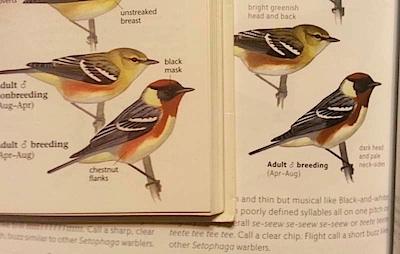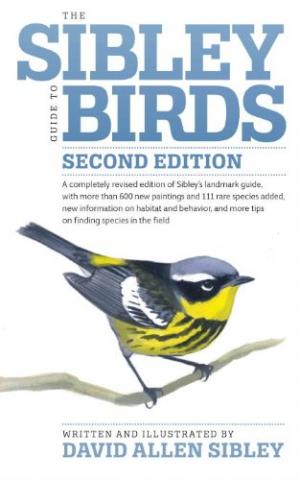Today is March 11, a date North American birders have been looking forward to for quite some time. This is the publication date for the second edition of the Sibley Guide to Birds by David Allen Sibley.
The first edition reached birders' hands nearly 14 years ago and almost instantly became the standard by which other guides were judged. The name Sibley has become as synonymous with the field guide as Peterson was for decades. Ask ten birders to recommend a guide and nine of them will at least mention Sibley, if not list it outright as the best. It's that well respected. (That tenth birder is the one who misidentifies a lot of birds, by the way.)
I have to admit that I have never owned the actual first edition. By the time I got into birding, it had spawned two smaller-sized field guides for the eastern and western birds. Those live in my car with duplicates on the shelf at home. I was advised to wait to buy the larger, more comprehensive guide since Sibley was planning a second edition soon. That was in 2010, and today that book is finally in my hands.
Sibley is respected for good reason. His approach took the old 'Peterson Method' of pointing out distinguishing field marks to the next level. Sibley's paintings are more subtle and nuanced than Peterson's. The birds are an amalgam of the variation you'll see within a species, without ending up looking like a Frankenstein of cluttered field marks. The birds very much 'feel' like they do in the field, while remaining stylized enough for a single painting to emphasize a collection of field marks. That is Sibley's genius.
Alongwith the paintings comes supporting text covering the vital measurements, physical description, habits and habitat, voice, and range. The second edition improves greatly upon the first in habitat description. The range maps have also been tweaked where needed, with Sibley's trademark attention to detail.
The voice descriptions have never been a selling point for me. Phonetic representations of birdsong are naturally challenging, but some are better than others. I have honestly found Sibley's more difficult to grasp than others in this regard. I can't make 'plurrri, kliwi, plurrri, kliwi' sound like birdsong in my head. Same goes for 'ttttttTTTTTTttttt.' Those are the American Robin and Blackpoll Warbler, respectively, for those of you wondering. In 2014, there's no substitute for recordings when learning bird voices.
The paintings have all been enlarged by at least 15 percent to show more detail, but another more troubling change is noticeable. Many of the colors are significantly darker than in the earlier edition and pocket guides. In some ways this might be good, as one of the few complaints about the first edition was that some colors were exceedingly vibrant. In this edition, several reviewers have noted darkened and muted reds and oranges, and I'd have to agree that on some birds the change is for the worse. Scarlet Tanagers, Northern Cardinals, and Red-headed Woodpeckers all seem darker than they typically appear in the field. This isn't much of an issue on those birds, since red parts stand out regardless of their shade.

An example of coloration changes of the Bay-breasted warbler from the first-edition guide, left, and the new second edition. Kirby Adams photo.
More troubling is the orange. In birds like Barn Swallow, Bay-breasted Warbler, and Black-headed Grosbeak, the oranges have been muted drastically to the point of not truly being orange anymore. The Blackburnian Warbler is accompanied by the text 'flaming-orange throat,' but the throat looks merely normally orange in the second edition while the first accurately shows the glowing color that catches the eye when a Blackburnian shows itself. Do these colors detract from the book's utility as an identification guide? For perhaps a half dozen species, yes. For the other 700 birds, it's not a big deal at all. No other warbler carries plumage even remotely similar to the Blackburnian, so no one's going to misidentify it as a Yellow-throated Warbler because the orange isn't bright enough in the book.
Some birds with orange or rufous appear unaffected. Western Sandpipers often have the rufous coloration on the scapulars exaggerated in field guides as a means of bringing it to the birder's attention. In this case, the first and second editions look nearly identical.
It's thought that the color issue is a problem at the printing level, although Sibley has claimed there would be no plans to alter colors in a second printing. It's also been noted that some review copies seem to show the dark colors to a worse degree than others. I'd suggest stopping at the bookstore and purchasing a copy with colors that suit your taste if they appear different.
The design of the book is similar to the first edition. Similar species are beside each other for close comparison, sometimes on a single page, other times with each species occupying an entire side of a double-page spread. The layout is airy, attractive, and uncluttered. I might even say a bit too uncluttered for my taste. White space is easy on the eye, but I sometimes hate to see a white area where another map or illustration would easily fit. Still, it's hard to argue with the aesthetics of the book as you leaf through. A cluttered layout might derail an inexperienced birder in search of a difficult identification.
I do still highly recommend The Sibley Guide, despite these quibbles. It's the standard for a good reason and will continue to be the guide I recommend first to any fledgling birder. An identification guide's job is to get the birder from a question mark to a name. Sibley does that better, for more species of bird, than any other guide I've used. That so much scrutiny is being placed on this book's coloring issues, and that I've devoted so much space to it here, is testament to how good of a guide it is. Was that bird a plover or a sandpiper? Sibley will get you there without overwhelming you. Not sure if that little brown job was a Vesper Sparrow or a Savannah Sparrow? Page 521 of the Sibley Guide is where you'll want to be. No matter your skill level, this remains the guide to have.





Add comment